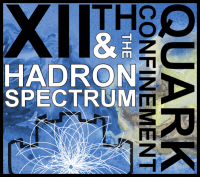Speaker
Description
The Micro Vertex Detector (MVD) will consist of four planar detector stations located at 5cm to 20cm downstream the target.
Its design is driven by the challenge to identify the decay vertices of particles carrying open-charm, which calls for a high spatial resolution ($\sim 5\mu m$) and a very light material budget of $0.3\%\ (0.5\%)\ X_0$ for the first (following) stations.
To match these requirements, we will employ $50~\mu m$ thin CMOS Monolithic Active Pixel Sensors, which will be provided by the IPHC Strasbourg.
The heat dissipated by the sensors is evacuated via support structures relying on highly heat-conductive carbon materials (CVD diamond, TPG), which is essential for vacuum operation.
Dedicated flex print cables are used to power the sensors and to transport the data corresponding to up to $\sim 7 \times 10^5 hits/mm^2/s$ (peak) towards the DAQ system.
We introduce our concept for the MVD and discuss technological challenges related to its mechanical integration.
Moreover, we show the results of a feasability study, which was carried out with a prototype (PRESTO) realizing a full quadrant of a detector station.
Summary
The Compressed Baryonic Matter experiment (CBM) forms a core experiment at the Facility for Antiproton and Ion Research in Europe (FAIR) using its future SIS-100 accelerator under construction in Darmstadt, Germany.
It is a fixed target experiment to explore the properties of hadronic matter in the regime of highest net baryon densities with beam energies of 4 to 12 AGeV (Au+Au) or up to 30 GeV (p-A).
The Micro Vertex Detector (MVD) of CBM is a silicon pixel detector, which is to reconstruct open charm and to support the tracking of low-momentum particles.
To match these goals, the highly granular, ultra-light, and vacuum compatible detector will be installed 5cm downstream the target, which introduces harsh requirements in terms of rate capability and radiation tolerance.
We introduce the concept and the technology of the MVD and discuss its design based on the results of a concluded feasibility prototype.




